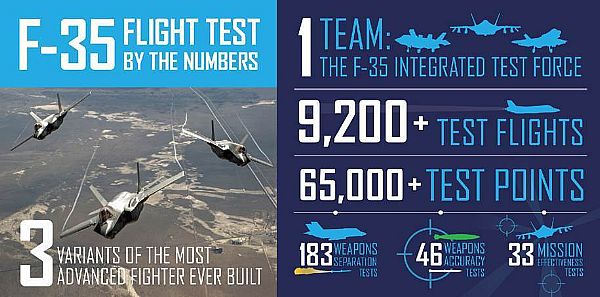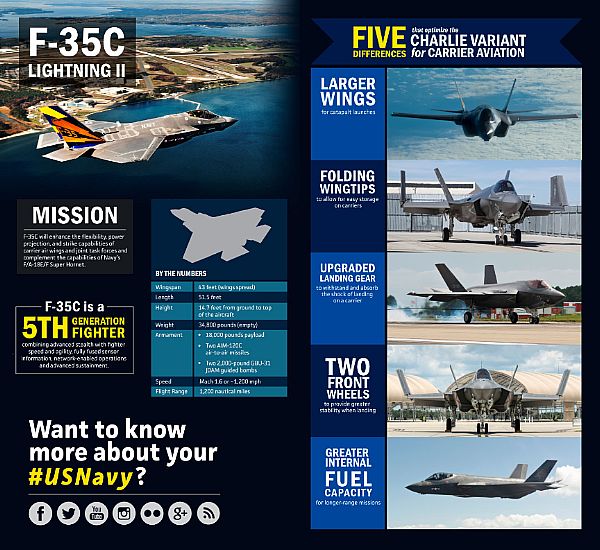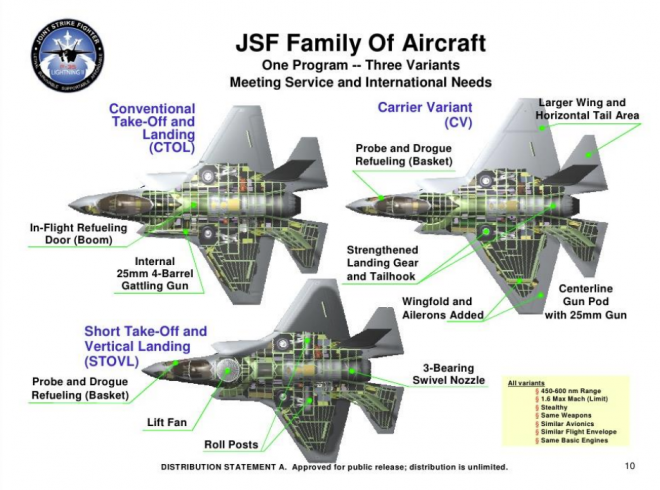
Lockheed Martin
- ロッキード・マーチン社/ノースロップ・グラマン社/BAEシステムズ社製 初飛行:2000年10月24日(X-35A) F-35Bデータ=全幅:10.66m(C型は13.10m) 全長:15.59m(C型は15.67m) 全高:4.34m(C型は4.44m) 翼面積:42.73m²(C型は62.05m²) 空虚運用重量:14,651kg(C型は15,785kg) 最大離陸重量:27,215kg(C型は31,751kg) パワープラント:アフターバーナー使用時定格推力191.35kNのプラット&ホイットニー製F135-PW-400推力偏向式排気口付きターボファン・エンジン1基(C型)、垂直離着陸時180.8kN(ロールスロイス製揚力ファンにより83.1kN、主エンジンのロールスロイス製推力偏向排気口により83.1kN、主翼付け根部2ヶ所のリアクション制御排気口により14.6kN)のプラット&ホイットニー製F135-PW-600ターボファン・エンジン1基(B型) 制限マッハ数:1.6 実用上昇限度:15,240m(Block
3F) フェリー航続距離:1,666km(C型は2,222km) 戦闘行動半径:833km(C型は1,111km) 兵装:機関砲:GAU-22/A 25mm回転式機関砲1門(A型のみ、B型、C型は取り外し式機関砲ポッド) 投棄可能兵装:機内搭載にはAIM-120 AMRAAM2発、1,000lb(453kg)GBU-31または2,000lb(907kg)GBU-32
JDAM2発を含む 乗員:1名 ユニット・コスト:$104,000,000(F-35B、低率量産)、$116,000,000(F-35C、低率量産)
- ※社内呼称モデル700(L-700)
- ※1996年頃に統合攻撃戦闘機(Joint Strike Fighter)計画が誕生し、1996年11月16日に概念実証計画(CDP)に進む担当会社として、ボーイング・チームとロッキード・マーチン・チームが選ばれた。計画機名称は、ボーイング・チームにはX-32、ロッキード・マーチン・チームにはX-35が与えられる。2001年10月26日にロッキード・マーチン・チームが勝者に選定され、次のシステム開発及び実証(SDD)段階(これまでは技術、製造、開発(EMD)と呼ばれていた)に進むことになった。そして、X-35からF-35に制式名称を改めた
- ※X-35の初期構成は1997年中期に確定した仕様220と呼ばれるものであったが、最終的なJSF設計(仕様230)に至るまでさらに変更が加えられた。提示されている基本型は、X-35A(アメリカ空軍向けの通常離着陸(CTOL)仕様機)、X-35B(アメリカ海兵隊およびイギリス海/空軍向けの短距離離陸垂直着陸(STOVL)仕様機)、X-35C(アメリカ海軍の艦載(CV)運用仕様機)の3種類
- ※X-35Bの後方排気ノズルは、ロシアのYak-141でも採用された3BSN(3 Bearing Swivel Nozzle)と呼ばれる技術データが提供されるもすでにアメリカ海軍でも1970年にコンヴェア社(後のジェネラル・ダイナミックス社)で、超音速STOVL機の設計として研究されたこともあるものでX-35Bに導入済み
- ※国防総省は、2006年7月7日にF-35の公式愛称をライトニングII Lightning IIと命名

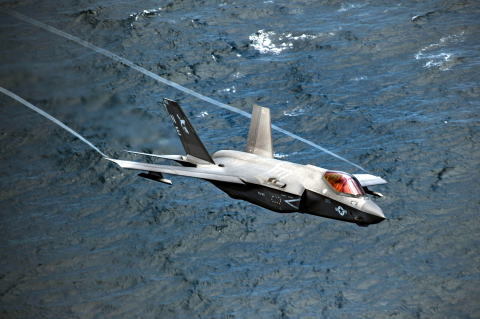
- ↑BAY OF BENGAL (Oct. 17, 2021) - An F-35C Lightning II assigned to the "Argonauts" of Strike Fighter Squadron (VFA) 147 flies over the Bay of Bengal as part of Maritime Partnership Exercise (MPX) 2021, Oct. 17, 2021. MPX 2021 is a multilateral maritime exercise between the Royal Australian Navy, Japan Maritime Self-Defense Force, U.K. Royal Navy, and U.S. maritime forces, focused on naval cooperation, interoperability and regional security and stability in the Indo-Pacific and is an example of the enduring partnership between Australian, Japanese, U.K. and U.S. maritime forces, who routinely operate together in the Indo-Pacific, fostering a cooperative approach toward regional security and stability. (U.S. Navy photo by Mass Communication Specialist 2nd Class Haydn N. Smith)
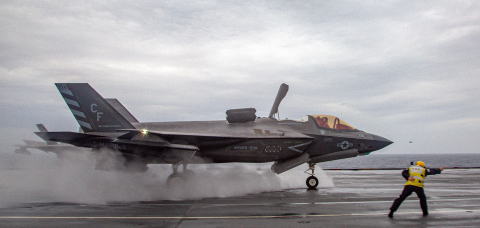
- ↑BAY OF BENGAL (Oct. 14, 2021) - US Marine Capt Gavin Holtz with Marine Fighter Attack Squadron (VMFA) 211, accelerates an F-35B Lightning II on the flight deck of HMS Queen Elizabeth in the Bay of Bengal. VMFA-211 is currently deployed with the United Kingdom's Carrier Strike Group 21 and scheduled to participate in Exercise Malabar alongside the US Navy, Royal Australian Navy, Indian Navy, and Japan Maritime Self-Defense Force. (U.S. Marine Corps photo by 1st Lt. Zachary Bodner)
- ↑PATUXTENT RIVER, Md. (April 11, 2018) - An information graphic about F-35 Lightning II flight testing created by Lockheed Martin and released by the F-35 Integrated Test Force at Naval Air Station Patuxtent River, Md. U.S. Navy graphic courtesy of Lockheed Martin. (Released)
- ↑WASHINGTON (Nov. 2, 2014) - A graphic describing the F-35C Lighting II carrier variant joint strike fighter. U.S. Navy photo. (Released)
- ↑Naval Air Station, Patuxent River, Md. (Feb. 10, 2001) -- The naval variant of the Joint Strike Fighter, X-35C, arrives at Naval Air Station Patuxent River, Maryland, flown by U.S. Marine Corps Major Art "Turbo" Tomassetti, a strike test pilot for Lockheed Martin. U.S. Navy photo by Vernon Pugh. (RELEASED)
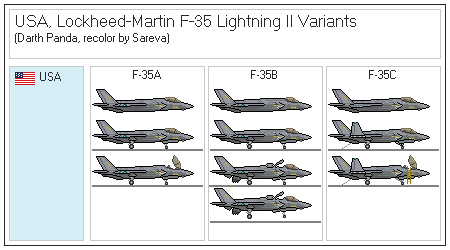
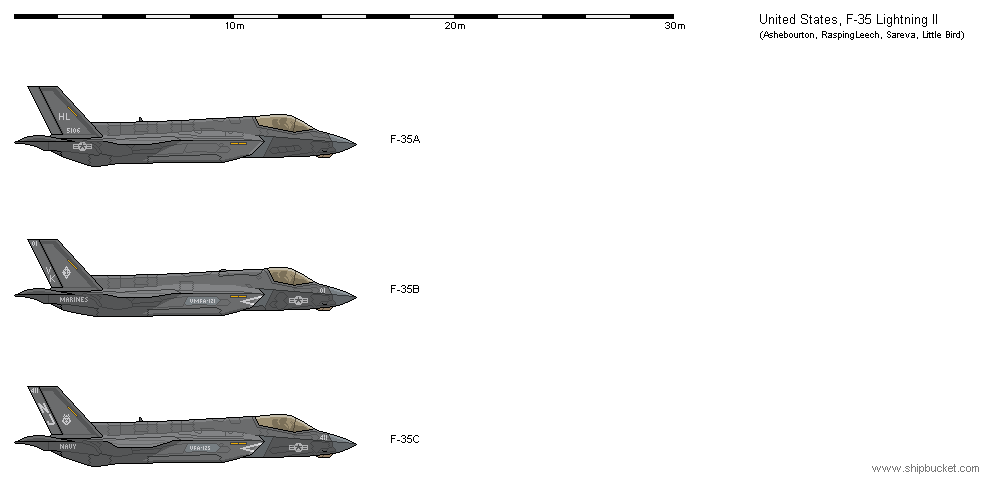
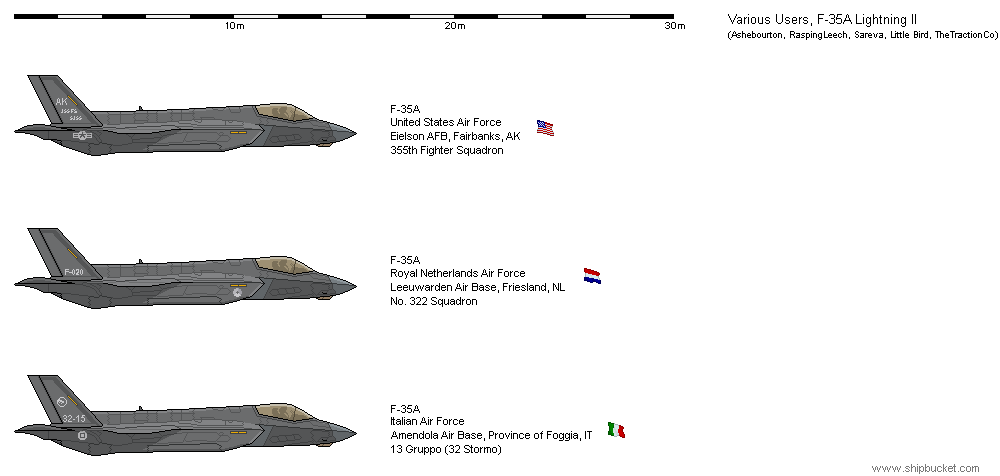

Update 23/08/10


